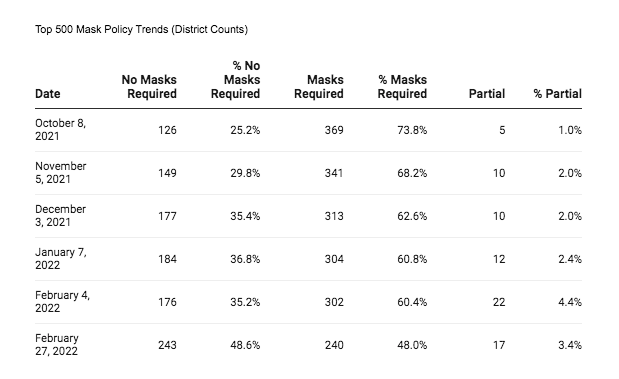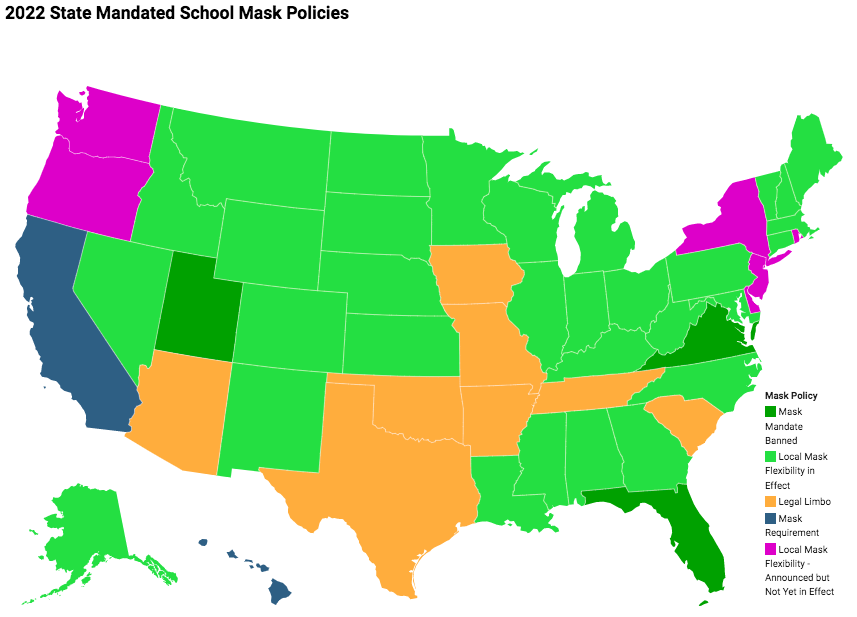For the first time the number of Top 500 districts that are mask-optional exceeds the number that are mask-required, and we expect that trend to accelerate this week and for the balance of the month. This week we look at planned ESSER III spending in the technology category, which currently projects to over $10 billion. School disruptions continue at their low level. More below.
1. Burbio's
Mask Policy Tracker has a continuously updated tracker of Top 500 district mask policies. As of Sunday, February 27th, 243 of the Top 500 districts are mask-optional, the highest level seen this academic year and an increase from 176 on February 4th. The figures in the chart are set to the effective date of the district's change, meaning a district that has announced a plan to switch to mask-optional won't appear as such until that date occurs. We expect that the number of mask-optional districts will accelerate in the coming weeks and we will keeping it up date in real time so it changes daily. Here are figures as of Sunday:
 |
- On Sunday afternoon New York Governor Hochul announced the state's school mask mandate will be removed Wednesday.
- A series of administrative and legislative approvals resulted in Maryland removing its mask mandate on Friday.
- In Illinois, where the state-wide school mask mandate had been overturned in recent court decisions, Governor Pritzker announced the government would be lifting its school mask mandate Monday.
- While not a mask-mandate ban, New Hampshire's DOE issued a "technical advisory" that no longer recommends universal face mask use, in either indoor or outdoor settings, including specifically in school settings.
Below is the recent state map. We will flip the "purple" states to "green" the evening before their mandates are lifted, so note that Massachusetts and Connecticut, with mandates changing February 28th, are now green, Maryland has gone green, and New York is purple.
 |
3. To give an overview of the changes to policies nationwide, here is a sample of recent announcements from states around the US.
- Wichita, KS "voted 4-3 to remove the mask mandate in schools and administrative offices effective at the end of the day on Thursday, March 10. Masks will be recommended but not required beginning March 11."
- In Illinois both District U-46 a district with over 50 schools, and Park Ridge-Niles District 64, use similar language in their mask-optional announcement: "Staff members are not responsible for monitoring your family’s mask choice throughout the day. We will also not be able to honor any special requests for seating preferences within the classroom and throughout the school."
- In Michigan, Dearborn and Plymouth-Canton are Top 500 districts moving to mask-optional among many districts in Michigan. Traverse City school district notes "mask shaming will not be tolerated and should be reported to building administration." The Trenton Superintendent writes about their move to mask-optional: "Though I appreciate the many emails of gratitude for the abrupt change, I also understand that some were very disappointed by the decision. . . For that, I would ask that we all are reminded of the necessity of kindness, compassion, and grace."
- In Indiana Gary, Benton Central, Penn-Harris-Madison and Jennings County ("Yesterday we received some great news . . .") were among many districts that went mask-optional in response to the Indiana Department of Health's recent changes to contact tracing which we reported on in last week's blog.
- In Colorado Durango School District will be mask optional on Monday, while Aspen School District and Summit School District went mask-optional last week. and
- In Maryland, St Mary's County Public Schools, Washington County Public Schools and Worcester County Public Schools will be mask-optional on Monday, and Baltimore County and Kent County schools will be mask-optional Tuesday.
- In North Carolina, Charlotte-Mecklenburg schools will be mask optional on March 7th, Robeson County Schools will be mask optional this week, while Guilford County Schools,Thomasville City Schools, and Rutherford County Schools were among many schools that went mask-optional last week.
4. Burbio's detailed
ESSER III spending database has detailed spending plans for over 3,000 districts representing over 60% of US students and accounting for over $67 billion of allocations. Currently 10% of all spending - which would project to over $10 billion - is being allocated to one or more of 15 sub-categories of technology spending we have identified, and this week we wanted to focus on this large category with some examples. The figure in parenthesis is the total ESSER III allocation for the district:
- Ontario-Monclair, CA ($61.9MM) is spending $686,785 on software tools "including but not limited to" fourteen vendors they name in their plan. "These resources will allow our teachers to maximize the use of technology, both in the classroom and for students who are at home for quarantine and participating in Independent Study."
- Milwaukee, WI School District ($505.8MM) will spend $20MM on Chromebooks and accessories, $11.9MM for "Essential instructional technology hardware for educator use," just over $1MM for STEM Career and Technical Education, $4MM for auditorium updates, $8.5MM for instructional subscriptions. $15.2MM for fiber optics, and $1MM for Esports, among many other categories.
- Balen Consolidated Schools, NM ($9.5MM) will spend $1.7MM to "purchase technology that is capable of meeting teacher and student's teaching and learning needs including streaming, uploading, and teleconferencing. BCS will also use these funds to employ a technology tech to help keep up with the increased volume of technology work orders and maintenance" and $500,000 to "purchase technology that engages students such as SMART boards, ensure connectivity, and adaptive technology."
- Sioux Falls, SD ($37.3MM) is spending $15.9MM for technology replacement over the life of the grant (hardware, software, and connectivity), $2.5MM on "audio enhancement equipment . to increase the volume of teachers’ voices that may be diminished by a mask," $550,000 for a digital records management system, $436,000 for "communication and feedback tools" for use with parents and students, $411,000 for "bus accountability pass swiping technology" and $75,000 for "livestream equipment to stream sporting activities."
- Montgomery County School District, TN ($58.5MM) is spending $4.3MM on technology including, among many categories, $1.3MM for a firewall upgrade, $180,000 for extended WiFi at Bus pick up spots, $73,500 for custodian cell phones, and $350,000 for an E sports extracurricular program.
- Calhoun County, AL ($15.5 MM) is spending on "laptops, desktop computers, ipads, printers for instructional partners, and viewsonics," an "Interactive Playground that . . . . promotes reading and math, but also has activities with mindfulness strategies, stress reduction, and other social and emotional activities. .. '' plus "3 Chromeboxes in every K-5 classroom" and almost $1MM on eighteen separate subscriptions and site licenses for software programs to improve academic achievement.
- Bloomfield, CT ($3.9MM) is spending on a wide array of tactics including $120,000 to replace 200 projector units, $150,000 for district-wide Chromebook replacement, $44,000 on 20 pre-wired Chromebook carts, $42,868 to replace 9 Smart Boards, and $54,000 to maintain 100 T-Mobile hotspots.
- Charles County, MD ($30.9MM) is spending $4.6 million to "to provide a robust, secure infrastructure network to support staff and student access to resources both on and off-site. . . . the current IT infrastructure was designed to support on-site learning. . .with the change to virtual and hybrid learning, there is a need to provide equitable access. . .
- San Juan, UT Schools ($6.5MM) will be using funds to construct a LAN Area Network that involves contracted help desk, field support, and software.
- Forsyth County, NC School District ($148MM) is spending $12.5MM on hardware, software licenses and support for students and staff.
- York City School District, PA ($35MM) details multiple five and six figure software license purchases across various grade levels plus $8.7MM for hardware for students and staff.
5. School disruptions continued at their lower level of the past few weeks: